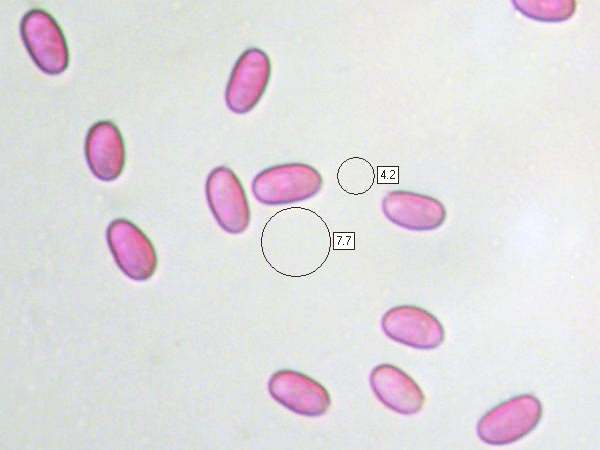Hygrophoropsis aurantiaca (Wulfen) Maire - False Chanterelle
Phylum: Basidiomycota - Class: Agaricomycetes - Order: Boletales - Family: Hygrophoropsidaceae
Distribution - Taxonomic History - Etymology - Identification - Culinary Notes - Reference Sources
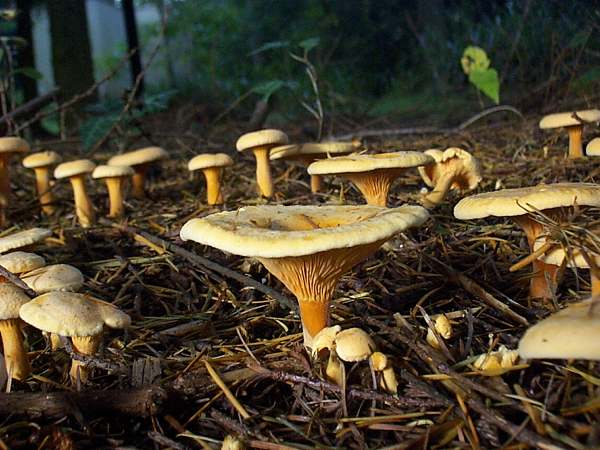
Hygrophoropsis aurantiaca, a gilled boletoid fungus, can easily be mistaken for the highly prized edible Chanterelle, Cantharellus cibarius, and although some consider it safe (but bitter tasting) to eat some concerns still remain about it. A distant relative of the Brown Rollrim, Paxillus involutus, which is now known to contain dangerous toxins, Hygrophoropsis aurantiaca is more closely related to pored boletes and, with a few notable exceptions, boletes are edible and some of then - Boletus edulis for example - are highly prized.
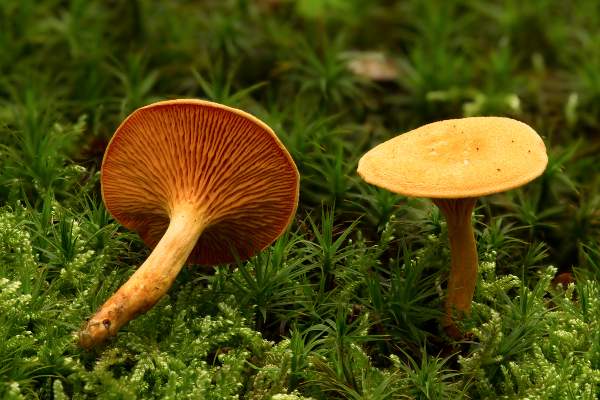
The fertile surface is covered with a repeatedly-forking gill-like structure which is quite distinctive and lacks the cross-veins found in Chanterelles. The reddish-stemmed group of False Chanterelles shown above were seen in a Spruce forest in Sweden during a foray in search of (true!) Chanterelles Cantharellus cibarius.
Distribution
Fairly frequent throughout Britain and Ireland, the False Chanterelle also occurs across mainland Europe and in North America.
Taxonomic history
When in 1781 the Austrian priest and naturalist Franz Xaver Freiherr von Wulfen (1728 - 1805) described this mushroom he gave it the binomial name Agaricus aurantiacus. (In the early days of fungal taxonomy gilled mushrooms were generally grouped under the genus Agaricus, since split up with most of its contents dispersed to other newer genera.) It was the French mycologist René Charles Joseph Ernest Maire (1878 - 1949) who, in 1921, transferred this species to the genus Hygrophoropsis, whereupon it acquired its currently accepted scientific name Hygrophoropsis aurantiaca. This mushroom is in fact the type species of the genus Hygrophoropsis.
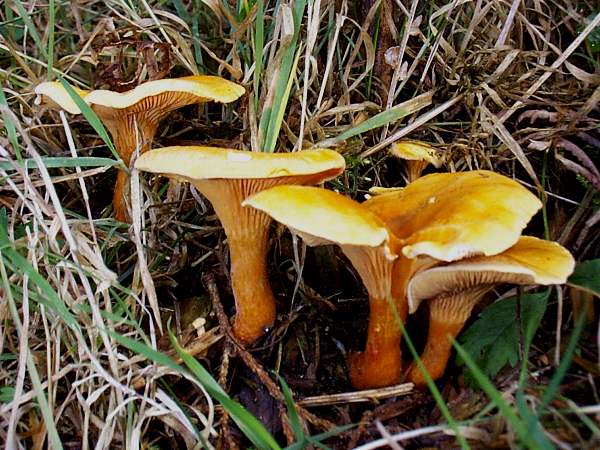
That this mushroom should be mistaken for an edible Chanterelle, Cantharellus cibarius, is understandable: one of its synonymous scientific names is Cantharellus aurantiacus (Wulfen) Fr. Other synonyms of Hygrophoropsis aurantiaca include Agaricus aurantiacus Wulfen, Merulius aurantiacus (Wulfen) Pers., Merulius nigripes Pers., Agaricus subcantharellus Sowerby, Cantharellus aurantiacus ß lacteus Fr., Cantharellus aurantiacus var. pallidus Cooke, Clitocybe aurantiaca (Wulfen) Stud.-Steinh., Clitocybe aurantiaca var. albida (Gillet) Rea, Clitocybe aurantiaca var. lactea (Fr.) Rea, Clitocybe aurantiaca var. nigripes (Pers.) Rea, Hygrophoropsis aurantiaca var. aurantiaca (Wulfen) Maire, Hygrophoropsis aurantiaca var. nigripes (Pers.) Kühner & Romagn., Hygrophoropsis aurantiaca var. pallida (Cooke) Kühner & Romagn., and Hygrophoropsis aurantiaca var. rufa D.A. Reid. Quite a lot, really!
Hygrophoropsis is a sparsely populated genus, with just five species currently recorded from Britain.
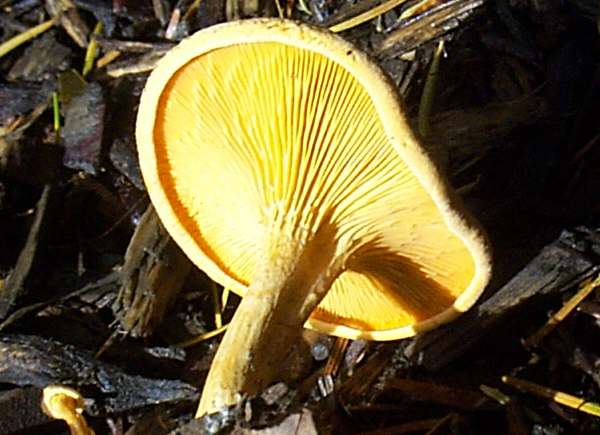
Etymology
The genus name Hygrophoropsis means resembling Hygrophorus. (The suffix -opsis comes from Greek and means 'similar to'.) In shape it is true that woodwaxes (Hygrophorus species) and the False Chanterelle are somewhat similar, but woodwaxes have broad gills which are, as the name suggests, waxy. If you are unfamiliar with woodwaxes, Hygrophoropsis hypothejus, commonly called the Herald of Winter, is a typical example. The specific epithet aurantiaca is a reference to the orange colouring of the False Chanterelle.
Identification guide
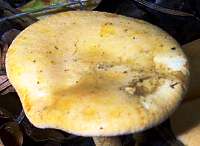 |
CapCap diameter can range from 2 to 8cm across. Initially convex, caps usually expand to become shallow funnels but occasional specimens remain slightly domed or simply flat when fully mature; orange or orange-yellow. (Cap colour is not a constant feature: some specimens are very pale indeed, while others are a very deep orange.) The cap margin usually remains slightly inrolled and is often wavy and irregular, although generally less so than that of Cantharellus cibarius, with which this mushroom is sometimes confused. |
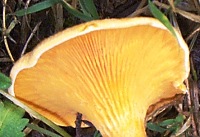 |
GillsOften a brighter orange than the cap colour, the repeatedly-forking gill-like spore-producing structures of the False Chanterelle are deeply decurrent and narrow. |
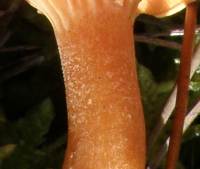 |
StemTypically 3 to 5cm tall and 5 to 10mm in diameter, the tough stems of Hygrophoropsis aurantiaca are the same colour as the centre of the cap or slightly darker, becoming progressively paler towards the base. The surface of the stem is slightly scaly near the apex. |
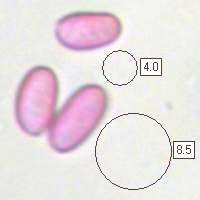 |
SporesEllipsoidal, smooth, thin-walled, 5-8.5 x 3.5-5μm; dextrinoid. Show larger imageSpore printWhite. |
Odour/taste |
Mildly mushroomy but not distinctive. |
Habitat & Ecological role |
Saprobic, most often found in coniferous woods and on acid heathland. |
Season |
August to November in Britain and Ireland. |
Similar species |
Cantharellus cibarius, a popular edible species found in similar woodland habitats, has wrinkled veins rather than gills. |
Culinary Notes
Although the False Chanterelle is not known as a seriously toxic toadstool, there are reports that some people have suffered hallucinations after eating this species. The False Chanterelle should therefore be treated with caution, and we recommend that it should be considered as inedible.
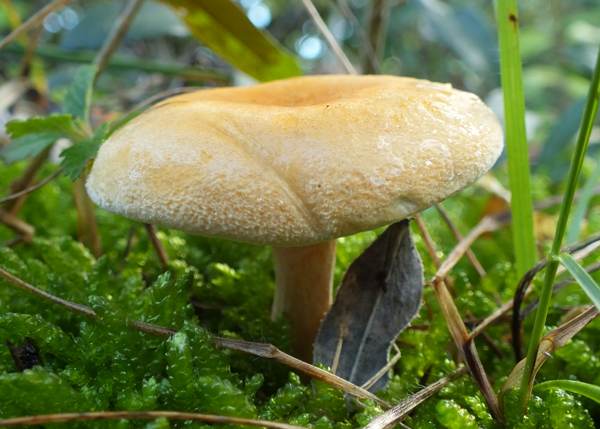
Reference Sources
Fascinated by Fungi, 2nd Edition, Pat O'Reilly 2016, reprinted by Coch-y-bonddu Books in 2022.
Funga Nordica: 2nd edition 2012. Edited by Knudsen, H. & Vesterholt, J. ISBN 9788798396130
Dictionary of the Fungi; Paul M. Kirk, Paul F. Cannon, David W. Minter and J. A. Stalpers; CABI, 2008
Taxonomic history and synonym information on these pages is drawn from many sources but in particular from the British Mycological Society's GB Checklist of Fungi.
Acknowledgements
This page includes pictures kindly contributed by David Kelly.
Fascinated by Fungi. Back by popular demand, Pat O'Reilly's best-selling 450-page hardback book is available now. The latest second edition was republished with a sparkling new cover design in September 2022 by Coch-y-Bonddu Books. Full details and copies are available from the publisher's online bookshop...
